
 |

|
 Michael B.
Kingston |
|
Professional Biography |
|
Courses Taught
|
| Many of the theoretical aspects of community
ecology were developed by biologists who studied the populations of organisms
that inhabit intertidal areas. On rocky shores, the low intertidal community
forms a dense assemblage of interacting predators, prey, and competitors
whose abundance is controlled by both physical and biological factors.
Easy access and the existence of easily recognized intertidal zones dominated
by a few species faciltitated the study of population-level processes that
produce community structure. Over the course of my professional career, my intertidal research has focused on the life history strategies that permit seaweeds and microscopic algal species to inhabit this stressful habitat. Although my continuing research interests focus on species of vertically migrating microalgae, particular within the genus Euglena, that form large visible patches on sandy beaches during low tides, my past research includes investigations into the ecological and physiological factors that affect the zonation of seaweeds in rocky intertidal areas |
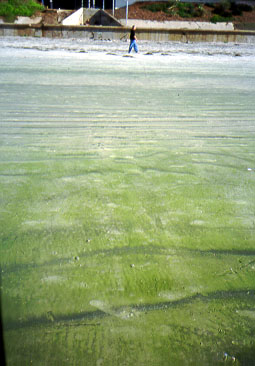 Euglena patch on California Beach
|
 West Coast Rocky Intertidal Seaweeds
|
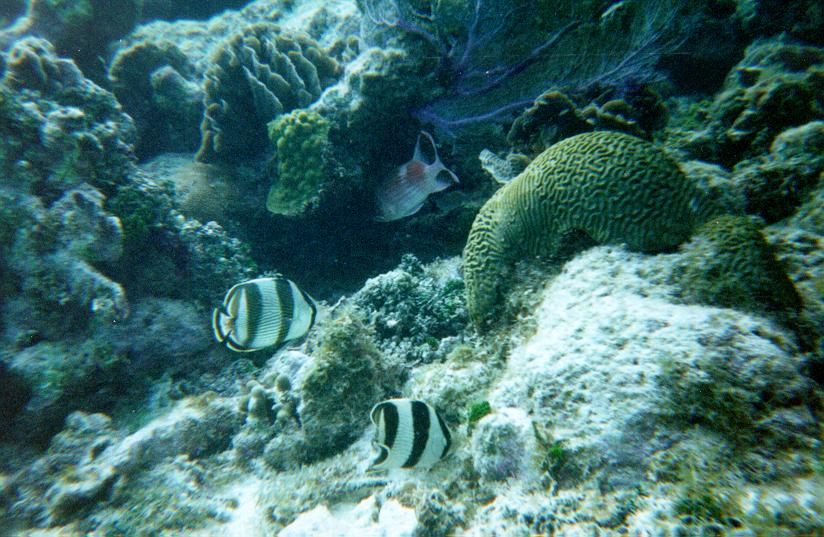
|
Tropical coral reef ecosystems are areas of high
biological diversity. The health of these ecosystems is
threatened worldwide
by global climate change, pollution, overfishing, disease, and the
impact
of ecotourism. I have supervised several undergraduate research
projects examining damselfish territoriality. Currently, I am
supervising a student who is completing her senior honors thesis
project on her research examining grouper population structure and
distribution along Long Cay and South Caicos in the Turks and Caicos
Islands.
|
| Tropical seagrass meadows are areas of high productivity but low diversity when compared to coral reefs. These meadows which serve as nurseries to fishes and invertebates help to stabilize the sandy sediments of coral reef lagoons. In Belize, these meadows are dominated by two species: turtle grass and manatee grass. For several year, students enrolled in my Field Biology in Belize course examined the preferences of nocturnal herbivorous fish for these two seagrass species. |

|
| Coral animals form the physical structure of tropical coral reef systems; however, a unique partnership between corals (animals) and microscopic algae algae (protists found within the cells of the coral) is responsible for the production of large coral reefs. The microalgae living within the cells of the coral's polyps are called zooxanthellae and they give the corals their characteristic colors--green, red, blue, purple, brown, orange, etc. This symbiotic relationship is termed a "mutualism" because both partners benefit; the algae are supplied with nutrients to support photosynthesis and the coral receives sugars excreted by the algal cells. The metabolic activity of the zooxanthellae also facilitates the formation of calcium carbonate to form the coral skeleton. Occasionally, coral reefs are struck by bleaching events which cause the zooxanthellae to leave their coral hosts. Bleaching events are caused by environmental stresses like high water temperature or increased UV penetration in the water column. A bleaching event may or may not kill the coral. Some species are resistant to bleaching and others show a remarkable ability to reacquire their zooxanthellae and recover. I shot this photo in the Gulf of Thailand during a major bleaching event in 1998--it shows a bleached finger coral surrounded by apparently healthy neighbors. |

|
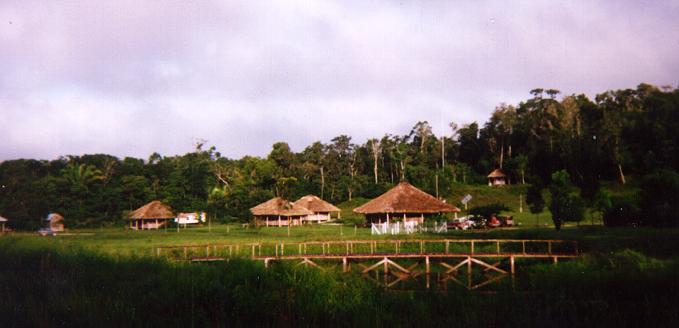
|
Tropical rainforests around the world are quickly disappearing as the result of overharvesting, conversion to agricultural land, and development. These ecosystems harbor a wealth of biological diversity and play a crucial role in global climate balance. I have been able to examine these ecosystems up close in Jamaica, Belize and Thailand. The photo on the left was taken at the La Milpa Research Staion within the Rio Brazo Conservation Area in northeastern Belize. |
| My research focuses on the evolutionary and ecological significance of vertical migration of microalgae that inhabit the sandy bottoms of marine, estuarine, and freshwater habitats. Even though these organisms are microscopic, their large numbers make them visible to the naked eye as they form green or golden brown patches on the surface of the sand. On the banks of North Carolina streams, Euglena viridis, forms patches from a few square centimeters in size up to a few square meters in size but the same species can form patches that exceed 200 square meters on the open beaches of southern California. In North Carolina, this species exhibits a diurnal pattern of vertical migration with the cells on the surface during the day and up to 5 cm deep at night. In California, it exhibits a tidal migration pattern with cells on the beach surface only during daytime low tide and more than 15 cm below the surface during daytime high tides and at night. | 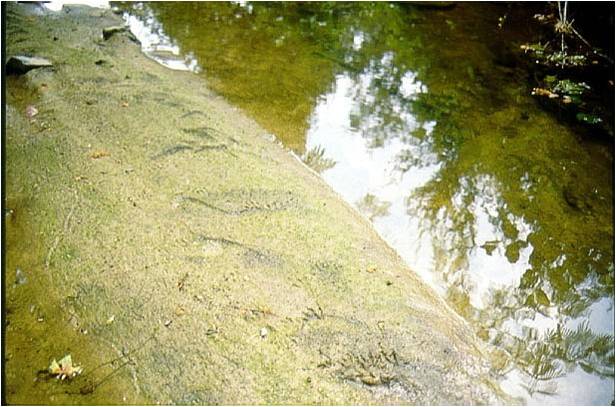 North Carolina Stream Bank
|
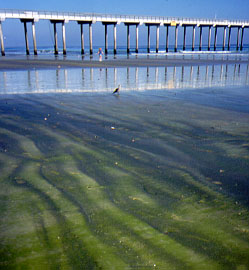 California Beach |
|
The microscopic algae in the photomicrograph at left belong to a group of protists known as diatoms. This species, Hantzschia virgata,
lives on intertidal sand and mud flats up and down the eastern seaboard
of the United States. They display a tidal rhythm in vertical
migration; at low tide they form golden brown patches on the surface of
intertidal sandflats and at high tide they are found up to 2 cm below the
sediment surface. The biological clock that controls this rhythm
is so accurate that the cells continue to migrate on time even after 10
days in the laboratory away from tidal changes. Although I had
not studied this species since completing my dissertation work on the
North Carolina coast, it represents the most dominant species in
my recent field samples from Sunset Bay, Oregon in April 2008.
|
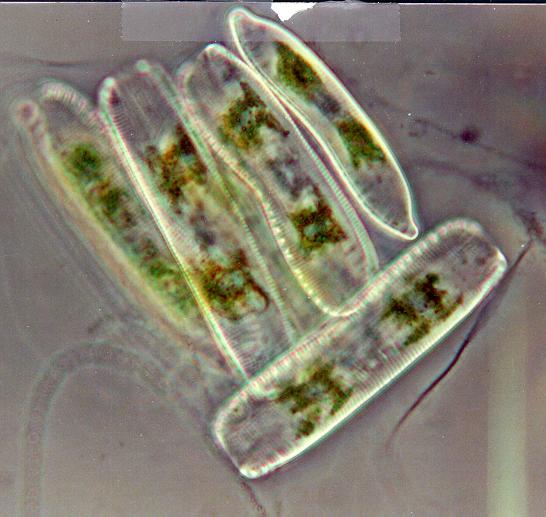 Hantzschia virgata diatoms
|
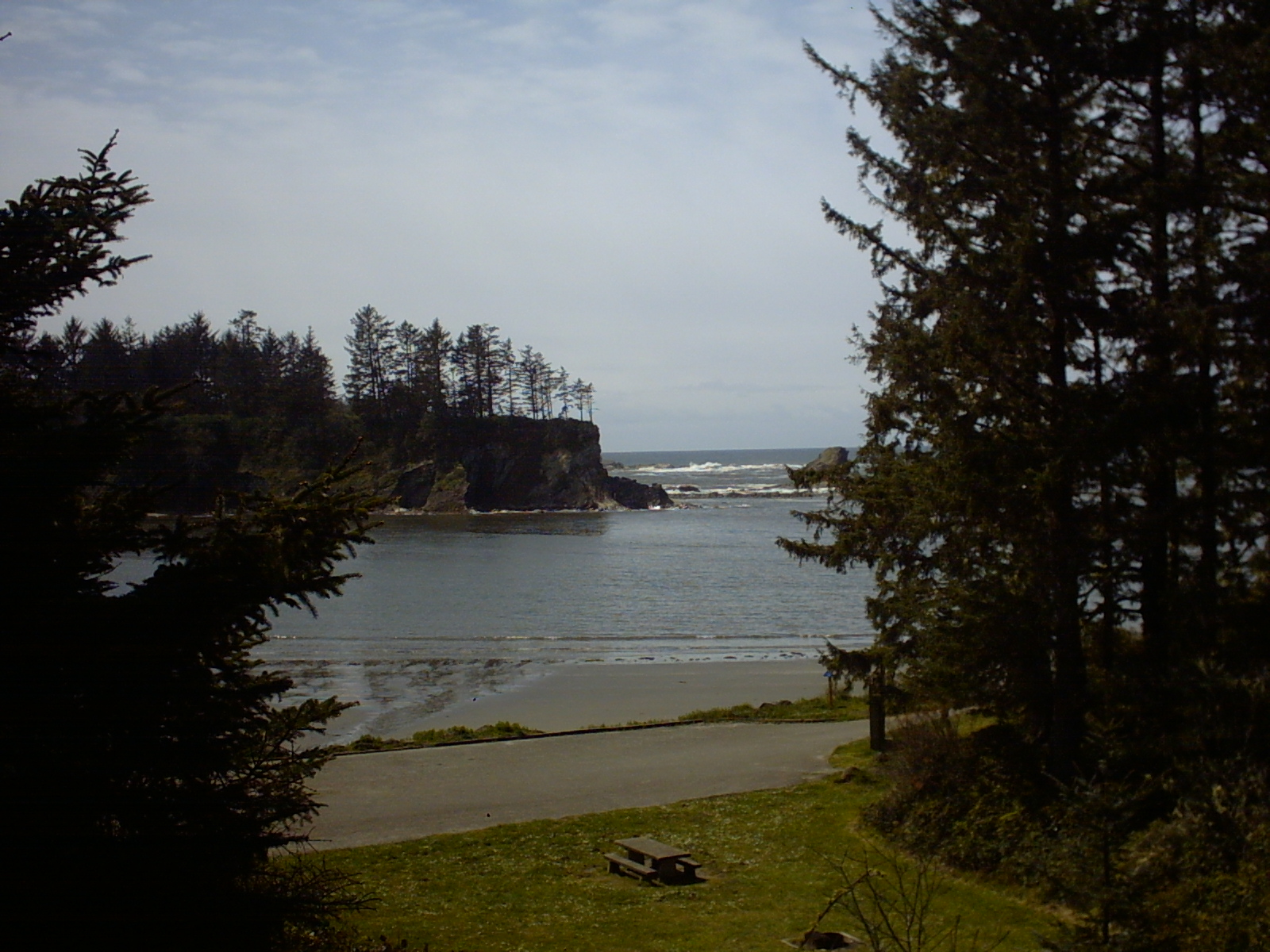 Sunset Bay, Oregon |

| Photobiology is an interdisciplinary subject that requires the integration of knowledge from the fields of biology, chemistry and physics. It involves the study of how biological organisms are affected by and use the electromagnetic spectrum of energy. My particular area of interest focuses on the visible portion of the electromagnetic spectrum in phototaxis and photosynthesis of microalgae. My masters work included a study of the photosynthetic physiology of the red seaweed Mastocarpus papillata. I also have supervised an undergraduate research project examining the photosensitivity of freshwater fishes to different wavelengths of visible light. |
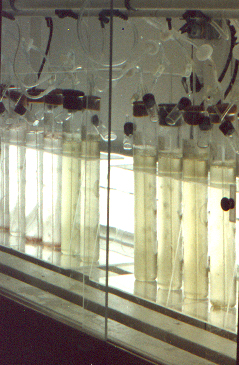
|
| My dissertation work included a study of the phototactic behavior of Euglena proxima under different nutritional regimes. Under normal conditions, many species of Euglena are spindle (micrograph to the right) or tear-drop shaped, motile, and capable of orienting themselves in a light gradient. They are particularly sensitive to wavelengths in the blue region of the spectrum. In addition to phototactic orientation (moving toward or away from a light source), Euglena also show photokinetic responses (accelerating or decelerating in response to a light gradient) and photophobic responses (altering direction or rate of movement when subjected to a sudden change in light level. |
|
| When subjected to high irradiance levels or low nitrogen levels, some species of Euglena lose their phototactic ability, become non-motile, and adopt a spherical morphology as illustrated by the photomicrograph to the right. |
|
|
SPONSORED STUDENT
RESEARCH PROJECTS
|
This Web site was last updated on 29 July 2008.